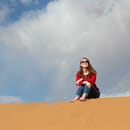Living in an apartment in Morocco is completely different than living with a host family. Besides the basic differences which are having to be independent and buying and making your own food, doing your laundry, and paying for the monthly rent of the apartment, there are other major differences as well. For the final part of my program in Morocco, we spend the last month working solely on our independent research projects. We are also given the opportunity to move out of our host family’s home or stay with them. Some students move out because they have to go to another city, such as Fes or Chefchaouen, for their research while others want the independence and move into an apartment in Rabat. I decided that I wanted to live in an apartment with five other girls from my program not only for the independence factor, but because I would be living with friends and the location of my apartment was much better for my research. Living with a host family compared to living in an apartment in Rabat is a huge difference and after spending two months living with a host family. Here are a few things I learned after my first week living in an apartment and in the commercial district of Rabat.
-
Buying food in Rabat
In Morocco, grocery stores aren’t that common and more of a new concept to Morocco. It’s not like in the States where if you run out of your microwavable Annie’s mac and cheese you can just walk or drive to the nearest grocery store and pick some up. Pre-packaged food (the kind meant for being an entire meal) isn’t something that is even really found in grocery stores. Most Moroccans usually go to the marketplace for their fruits, vegetables, meats, and fish while the hanoot (a small store that either you can walk into or stand in the street and order things from the person behind the counter) for flour, eggs, water, and similar such items. I usually end up going to the nearest grocery store to me, a French chain called Carrefour, which is about a ten-to-fifteen minute walk from my apartment since the marketplace in the Medina is farther away.
-
Finding your way through the commercial center is a lot easier than in the old medina
I’ve already talked about how the streets of the Medina in Rabat are like a labyrinth, consisting of tiny alleyways with twists and turns that are seemingly never-ending and almost as though it wants you to get lost. The commercial district, however, is not begging you to get lost and much easier to find your way around. The streets are bigger and there are sidewalks, which means you don’t have to constantly be on the lookout for a motorcyclist to be zooming right past you. Another positive about the streets, they actually have signs. In the Medina some streets won’t even have signs, you just have to know what street it is. In the commercial district, the streets have signs which help you find where you’re going.
-
The walkway in front of the Parliament building is my new favorite thing
There is this small strip of green in the middle of the roads that is in front of the Parliament building in Rabat. It’s less than a five minute walk away from me and is absolutely beautiful, no matter what the weather is. There is a single, long strip of green grass stretching down the road and on both sides, big pedestrian walkways and benches for people to sit. Flanking each ends of the strip are palm trees which stretch as far down as the grass. It’s a peaceful oasis in the middle of the busy, hectic, and always loud commercial district of Rabat. Usually, when I’m walking down it, I catch an old man throwing food for some birds or a family walking down as the little kid chases the birds away.
-
The view from my apartment
The view from my apartment is absolutely spectacular and being on the top floor makes the view even better. On our main balcony (we have three), you can see on your right side in the distance, the Atlantic ocean, while on your left side, you can see the Assouna mosque (pictured above). On the bigger balcony, there is a table with chairs that I sit out in the morning and do my work, listening to the sounds of the bustling city and the occasional call to prayer that echoes from the Assouna mosque five times a day. In the afternoon, when you look at the buildings in the distance, they become slightly hazy due to the heat on the buildings from the sun.
Anywhere you go in Rabat, it’s going to be beautiful. The medina is absolutely beautiful and will always have a special place in my heart but I like living in the commercial district more. It’s much easier to get around, there’s more to do, access to things are easier (such as the tram station, train station, easier access to taxis, more places to buy food, etc.) and there are also a lot more young people in the commercial district, which makes me feel a little bit less like a fish out of water.

